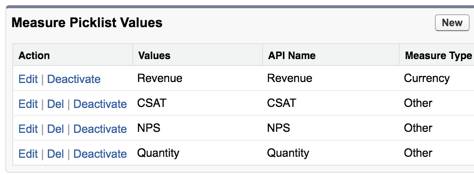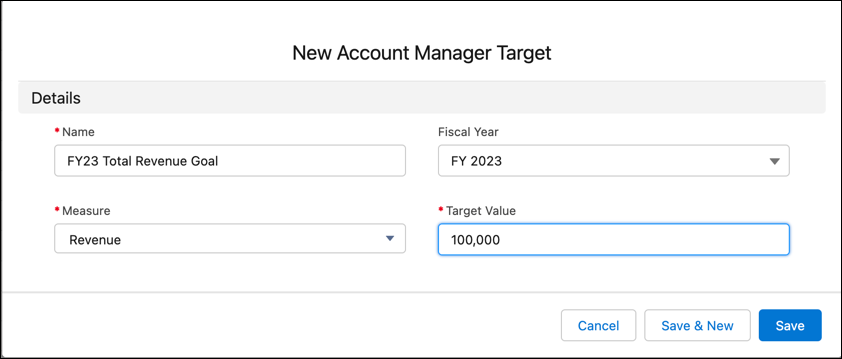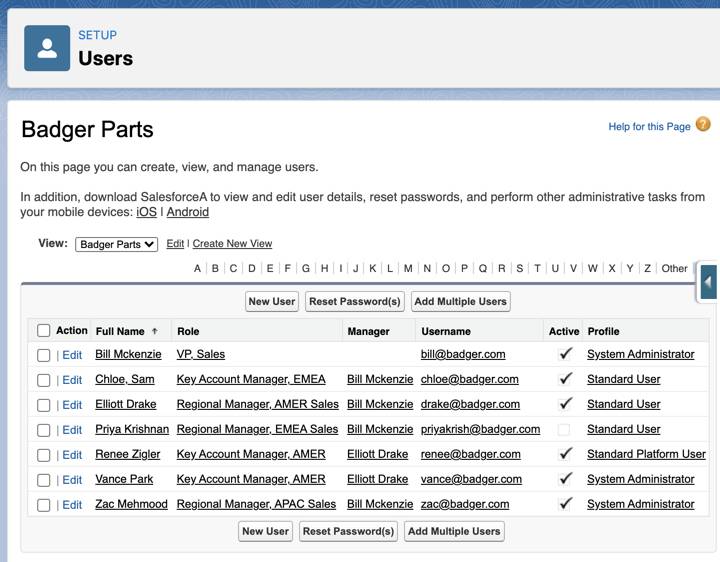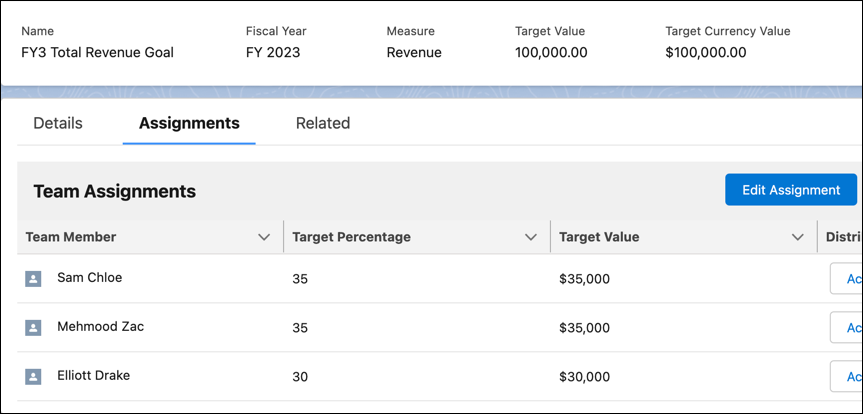Create and Assign Targets
Learning Objectives
After completing this unit, you’ll be able to:
- Explain how to distribute targets across a sales hierarchy.
- Create account manager targets.
- Assign targets to your team members.
Follow Along with Trail Together
Want to follow along with an expert as you work through this step? Take a look at this video, part of the Trail Together series.
(This clip starts at the 9:28 minute mark, in case you want to rewind and watch the beginning of the step again.)
Start at the Top
Before Bill creates targets for his team and passes down the information to his direct reports, he finds out how target distribution works.
With Manufacturing Cloud, top executives can create financial or nonfinancial targets and then allocate percentages to their direct reports. An executive can distribute the target value based on accounts and products. They can also divide the targets into monthly or quarterly targets for operational efficiency.
When each direct report gets a share of the overall target, they can again allocate it further among their direct reports. The cycle continues till each account manager at every level of the sales hierarchy ends up with a target that they must work toward.
Create Targets for the Fiscal Year
Bill wants to create revenue targets for the upcoming fiscal year and distribute the total revenue target among his team members: Sam, Elliott, and Zac. Once each direct report gets their target, they can either keep a part of the target for themselves and distribute the rest, or distribute the entire target and add additional targets for their direct reports to achieve ambitious sales numbers!
Here’s how Bill creates revenue targets for the sales team for the upcoming fiscal year FY23.
- From the App Launcher, enter
Account Manager Targets, and select it. - Click New on the Account Manager Targets home page.
- For Name, enter
FY23 Total Revenue Goal. - For Fiscal Year, select the next fiscal year. Bill selects FY 2023.
Bill can select the current fiscal year, the next fiscal year, or the fiscal year after that. Cindy defined Rayler Parts’s fiscal year in Setup, and that’s what Manufacturing Cloud uses for account manager targets. - For Measure, select Revenue.
Note: In addition to Revenue, Cindy has added some custom measure values in Object Manager, including Customer Satisfaction (CSAT), Net Promoter Score (NPS), and Quantity. Bill can always create other targets for these measures if required.
- For Target Value, enter
100,000.
Because revenue is a currency-based measure, the values are in the default org currency that the admin defined in Setup. - Click Save.

Bill has successfully created a high-level revenue target. It’s now time for him to assign targets to his three team members.
Assign Targets to Your Team Members
Cindy has already configured the Manager Hierarchy in Setup. She’s given managers the ability to view and assign targets to their direct reports.
- From Setup, search for
Usersin the Quick Find box, and select Users. - Search for Sam Chloe and click Edit next to her name.
- In the Approver Settings section, click on the Manager field.
- Search for and select your name.
- Click Save.
- Repeat steps 2–5 for the following users: Elliott Drake and Zac Mehmood.

Bill assigns the targets he created for his team members.
- From the App Launcher, enter
Account Manager Targets,and select it. - Click FY23 Total Revenue Goal to open the record.
- On the Assignments tab, click Assign Targets. You can see the following members in the Team Assignments section of the Assignments tab.
- Sam
- Elliott
- Zac
- Here you can enter either a percentage of the overall target value or a target value for each team member. Let’s enter a Target Percentage for them:
- Sam:
35 - Zac:
35 - Elliott:
30
- Sam:
- Click Save.
 Notice that when you enter the target percentage, Manufacturing Cloud automatically populates the target value. And it works the other way too. If you enter a target value, the app automatically shows you the target percentages. Bill finds it easier to assign a percentage and lets the application calculate the target values.
Notice that when you enter the target percentage, Manufacturing Cloud automatically populates the target value. And it works the other way too. If you enter a target value, the app automatically shows you the target percentages. Bill finds it easier to assign a percentage and lets the application calculate the target values.
The sum of the target assignment values need not be equal to the overall target value. It can be less than or more than the overall target value. This allows for self-assignments by the owner. Bill hasn’t allotted any target percentage to himself because he is the overall head of sales for Rayler Parts and currently doesn’t handle any key accounts himself.
Explore List Views
Bill can now check the targets assigned by him in a list view. On the Account Manager Targets home page, he can select the Assigned by Me list view. This list view displays the records of all the account manager targets Bill has assigned. This list also includes all the targets he created because he is the owner of these target records.

If anyone assigns a target to Bill, he can also make use of the Assigned to Me list view to view such records. In addition to the two default list views, Bill is glad to see that he can also create his own list views. He creates one for revenue targets and one for other measure types.
Coming Up Next…
For a sales team, it is not enough to create and assign targets. Account managers need clear direction on how to achieve these targets. In the next unit, you see how Bill can distribute targets based on time period, accounts, and products to add granularity to targets.
